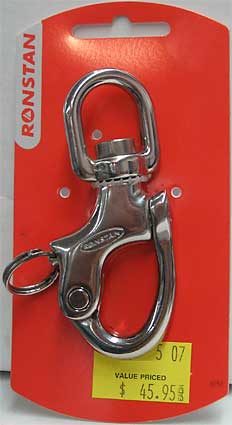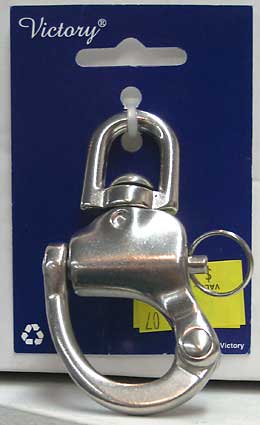In the last few years we’ve seen an increasing number of low-cost items of
sailing equipment from Asia generally and China particularly. The trend started
with cabin hardware – hooks,
hinges and the like, and has expanded recently to include running rigging
gear such as u- and bow-shackles and snap-shackles. Thus far we haven’t seen
anything made from engineered plastics, but with projects like the Flying
Tiger sportboat, Chinese manufacturers have signalled their willingness (as
if we needed reminding) to expand their reach.
Usually the Chinese gear looks similar to the hardware we’re used to,
whether from Perko, Ronstan or Wichard (three widely copied sources); innovation
isn’t yet a major feature. The question is, how does it perform and how much
does it matter?
Taking the second question first, we suggest that in cabin hardware,
performance isn't critical. If a door hinge fails, it’s a nuisance, little
more. With rigging hardware, failure may result in a spoiled afternoon, a
disappointing race or personal injury, so you want to avoid it, even if the
added assurance costs some money.
Added assurance does cost money. Looking at the comparative cost of snap-shackles,
which is the product that started this enquiry, the difference between our
established brands and the Chinese copies is about 300%. The Ronstan snap-shackle
shown here retails for C$45.95 (Ronstan bought Nicro Fico’s hardware operation).
The Wichard snap-shackle
retails for C$39.95. The Victory shackle, of roughly comparable size, lists
for $14.95. Incidentally, the retailer name has been blocked out to avoid
pointless cavils about the specifics of price; the point is the relative
difference.
The difference is not merely in price. First, and most important, the Ronstan
shackle card provides both a Maximum Working Load (1600 Kg) and a Breaking
Load (3200 Kg). The Wichard shackle card states loads of 1200 Kg and 2000 Kg
respectively (the shackles are shown here as approximately the same size, but
the Wichard is smaller). There is no comparable information on the Victory shackle.
Make of that what you will, but the absence of application information doesn’t
speak of great confidence in the product by its manufacturer or importer.
Second, unlike Ronstan or Wichard, Victory and similar manufacturers provide
no information about how their products are made or from what. True, many
of us couldn’t decipher the information on our own, but over the years, people
with better knowledge of metallurgy and metal-working have acknowledged that
Ronstan and Wichard hardware is well made; their approval provides
a foundation for the sailing community’s experience that these items perform
as we want and expect them to perform.
Two processes are principally used in making snap-shackles and similar hardware, forging (Wichard)
and investment
casting (Ronstan). The links lead to Wikipedia
entries on the processes but here briefly are some of the listed benefits:
Forging results in metal that is stronger than cast or machined metal parts.
... during forging the metal's grain flow changes into the shape of the part,
making it stronger. Some modern parts require a specific grain flow to ensure
the strength and reliability of the part.
and
Special characteristics of the Investment Casting process [include]:
- High production rates, particularly for small components
- High dimensional accuracy and consistency
- High integrity castings
The Victory shackle is probably made by the investment casting process. It’s
the logical choice – investment casting has been around since the early
Egyptians, so the barriers to setting up an investment casting plant are low.
First-class investment casting, however, requires knowledge, complex process
controls and appropriate material, all three of which can be expected to be
fully in place in the Ronstan operation while the Victory plant is shuffling
along with bits and pieces of these three requirements.
Victory and other Asian producers are good at visual quality – the shackles
are consistent in shape and nicely finished – what could be wrong with
them? The locking pins are too short (they're also inconsistent in length,
an indicator of a serious quality management failure in the plant, and their
action is sticky), but there is another, hidden defect – material.
A good metal-working operation knows precisely what materials are going into
its melting pots and how that material is treated on the way to becoming a
finished product: heating levels, cooling rates, pressure applied and so on.
The result is a very specific combination of attributes in the finished piece,
one of those being resistance to deformation under load. Companies like Ronstan
and Wichard know their processes and can ensure those attributes are present.
We can infer that plants like Victory cannot ensure
their products' attributes, since while there are no reports
of Ronstan or Wichard shackles deforming or failing at the hinge, there are
lots of reports of Chinese snap-shackles doing so, such as the following from
Scott Schoeler of Scot-Free.
"In doing the Trans-Erie this year, we found ourselves at 11:30pm in 35-knot
winds which blew the #2 out of the foil track. Alone on the foredeck, I wrestled
it under control but the halyard snap-shackle pin had deformed, preventing
me from being able to open it and release the head. I wrapped
the halyard around my wrist, cut the shackle off and pushed the sail down
the hatch. The #3 came back up and I raised it with the halyard tied to the
head.
"The owner bought the cheap one thinking
he couldn't imagine ever needing the load ratings of the expensive one. The
loads weren't that great, but the "no-name" shackle deformed. I
remember his words back at the dock, looking at the deformed shackle: '...it's
like catching a liar – how do you ever really trust him again, and on a sail
boat, all you've really got is trust. You've got to trust your crew, boat
and equipment.' The owner replaced the cheap shackle with one from Wichard."
Scott recently turned up a report on knock-off Rule bilge pumps. The Chinese
copy was superficially identical to the original Rule 2000 pump. The difference
lay in the pumps' performance; the genuine pumps will run for 5,000 hours (208
days) continuously while a knock-off failed after 45 minutes. The same report
also discussed counterfeit Faria engine gauges that copied every detail, including
certifications and test stamps.
"The article adds to the original Black Arts information," says
Scott, "in that it brings out the issues of IP theft and the greater harm caused
by the piracy. The issue goes beyond simple copy-cat, patent infringement and
threatens engineering designers and manufacturers, who are asking; 'If nothing
I design and manufacture is safe from pirates and I have no recourse, why go
to the expense and trouble.' We all will feel this loss. I’m not a protectionist
but I do believe in 'voting with my feet' and not opening my wallet to these
knock-offs, no matter the tempting price and no matter where it is used on
the boat."
There are also anecdotal reports of concern from
industrial safety commissions about Chinese industrial hardware that has failed
because of hidden voids in the metal or inappropriate materials, so people
have been injured. This sort of thing is virtually unheard of in North American
and European hardware, but too common in Chinese hardware.
So where does this leave us? Scott Schoeler and I discussed the issue while
this page was being written. Scott is a marine surveyor and has seen more than
he cares for of knock-off gear in his work, plus as related
above, he's experienced the consequences of its failure in conditions where
that failure should not have occurred. His condemnation is absolute, from rigging
hardware to cabin hardware.
"Is there any place for the knock-offs? Nope
– not in my opinion. Not on
my boat. Is there a market for it? Yup – people love a bargain. New boat
builders are using it to create a price-point boat. To the people who buy
boats equipped this way, new or used... caveat emptor."
My own opinion is not quite there. I believe that cheap shackles
should
never be used overhead, for obvious reasons, or in any location where
the load could exceed what you can hold by hand (which effectively limits
them to tasks like holding
your keyring or attaching a kellet to your anchor rode, a low-load task for
which a shackle is better suited than the more commonly used carabiner). Aesthetics
may also be an issue; we have rings tied to the pulpit and rails to which we
attach sail bags and oddments of gear. These rings looked like stainless steel
when bought, but over about two years have developed patches of rust – in
fresh water.
Cabin hardware may be less critical. If a cupboard hinge loses its plating
(or simply fails), it's an inconvenience and seldom more.
Somewhere in the narrow gap between these two positions, you can find your
own place.
This begs the question of how you find out what is good and what isn't. Scott
likes Practical Sailor, though while he finds some reviews spot-on,
he takes the magazine "with a grain of sea salt" overall. I'm not
so enamoured. It's a long sight better than the mass-circulation
magazines like Cruising World, Sailing World or Sail that
will never slag an advertiser. An ostensibly authoritative review
of radar reflectors some years ago left the impression that the popular Mobri
devices (and similar tubular reflectors by Plastimo and other manufacturers)
are a reasonable choice despite the magazine's tests having established that
the Mobris are poor performers, a result in line with US Sailing's findings that
Mobris are "essentially invisible". (Mobris conveniently meet the
Canadian regulation requiring carriage of a radar reflector, but if you want
to be visible on radar, get a Davis aluminum and hang it high in the "catch-rain"
orientation.) One Canadian yacht-builder has repeatedly taken issue with PS's
findings; PS's recommendations are the products they frequently have warranty problems with.
Perhaps the reader should take Practical Sailor's recommendations
with a lump of salt rather than a grain.
In the end, it may be that the best filter for what is going
to work and what won't is common sense. At one-third the price of high-quality
shackles, Chinese shackles look like a deal that is too good to be true
– and that's exactly what they are,
too good to be true.
– David Weatherston, Towser




